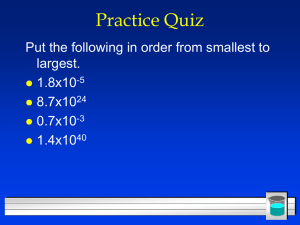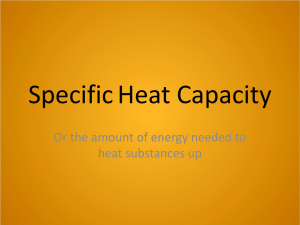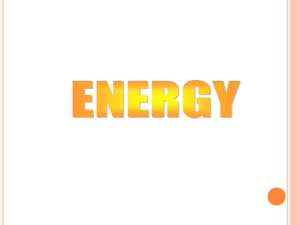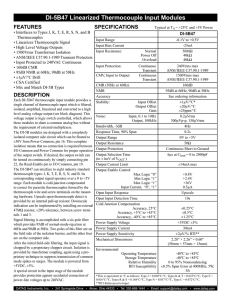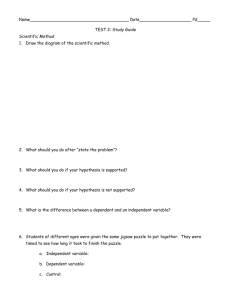Welcome to AP Chemistry
advertisement
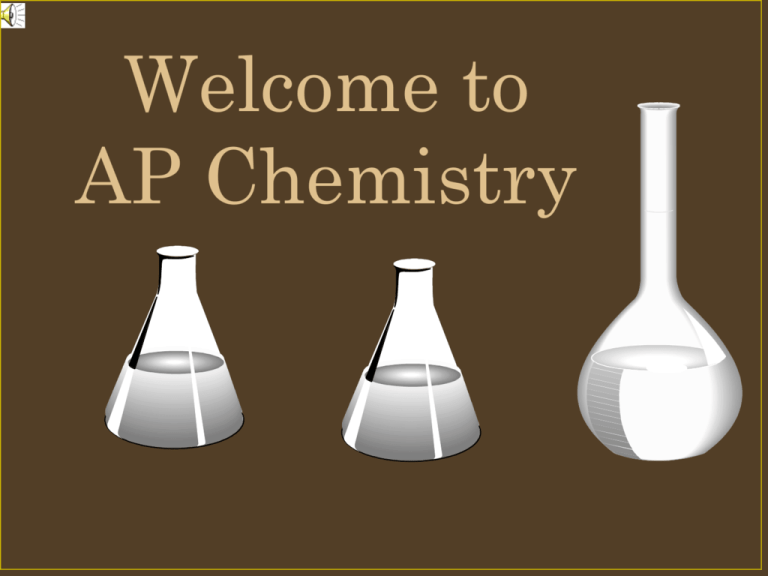
Welcome to AP Chemistry What is AP Chemistry? • It is several things • Equivalent of 1 year college inorganic chemistry class • A class that will prepare you for a test – May 17 • Hard work • A wonderful way to start the day • Now on to the details Rules and Procedures • You know the basic rules but here are a few that are specific for this class • No food drink or gum • LATE WORK • If you forget to bring in your homework, I will accept it ONE day late with a parent's signature, for full credit. • I will not accepted it any later. Rules and Procedures • MAKE-UP WORK • It is your responsibility to make up all the work you missed. You have the same number of days that you were absent to turn in the missing work. • Pick up any missing work, and notes before or after class. • If you miss a test or quiz, it must be made up outside class. Rules and Procedures • TARDIES • You will be allowed one ”free" tardy per semester. • The second and every subsequent tardy will result in a detention. • Repeated tardies will result in parent contacts, and referrals, AND MAY RESULT IN BEING DROPPED FROM THE CLASS. Rules and Procedures • PASSES • Since every minute of class time is valuable, hall passes will be given only on an emergency basis, with a limit of one per semester, except under special circumstances. Rules and Procedures • LAB- Because of the importance of safety in the lab, violation of laboratory safety rules and procedures may result in loss of lab privileges. Grading • Percentage scale 94-100% A 90-94% A87-90% B+ 84-87% B 80-84% B75-80% C+ 70-75% 65-70% 62-65% 58-62% 55-58% 0-54% C CD+ D DF Grading • Quarter Grade – Tests 50% – Homework/Classwork 20% – Quizzes 15% – Lab Reports 15% • Semester Grade – 40% from each quarter – 20% on final Extra Credit!! • Assignments will be provided approximately mid- quarter. • They may be turned in any time until the due date,(during the last week of the quarter) • Extra credit may be used to raise the quarter grade by up to one letter grade. • Extra credit is meant to be extra, so it will not be accepted if more than 10% of the other assignments are not turned in. What you need for class • • • • Paper Pencil or pen, Calculator- scientific Book? – Not unless I let you know • Lab Notebook Internet Ready • http://mrgreen.tierranet.com • My email is tvgreen@aol.com Why First Period? • College chemistry labs take more than 56 minutes, • To do those labs we will have to come early • I will give you notice of when Any questions? • Lets get started Significant figures • Meaningful digits in a MEASUREMENT • Exact numbers are counted, have unlimited significant figures • If it is measured or estimated, it has sig figs. • If not it is exact. • All numbers except zero are significant. • Some zeros are, some aren’t Which zeroes count? • • • • • • In between other sig figs does Before the first number doesn’t After the last number counts iff it is after the decimal point the decimal point is written in 3200 2 sig figs • 3200. 4 sig figs Doing the math • Multiplication and division, same number of sig figs in answer as the least in the problem • Addition and subtraction, same number of decimal places in answer as least in problem. More Preliminaries Scientific Method Metric System Uncertainty Scientific method. • A way of solving problems • Observation- what is seen or measured • Hypothesis- educated guess of why things behave the way they do. (possible explanation) • Experiment- designed to test hypothesis • leads to new observations, • and the cycle goes on Scientific method. • After many cycles, a broad, generalizable explanation is developed for why things behave the way they do • Theory • Also regular patterns of how things behave the same in different systems emerges • Law • Laws are summaries of observations Scientific method. • Theories have predictive value. • The true test of a theory is if it can predict new behaviors. • If the prediction is wrong, the theory must be changed. • Theory- why • Law - how Observations Hypothesis Theory (Model) Modify Experiment Prediction Law Experiment Metric System • • • • Every measurement has two parts Number Scale (unit) SI system (le Systeme International) based on the metric system • Prefix + base unit • Prefix tells you the power of 10 to multiply by - decimal system -easy conversions Metric System • • • • • • • Base Units Mass - kilogram (kg) Length- meter (m) Time - second (s) Temperature- Kelvin (K) Electric current- ampere (amp, A) Amount of substance- mole (mol) • giga- G Prefixes 1,000,000,000 109 106 • mega - M 1,000,000 • • • • • • 103 0.1 10-1 0.01 10-2 0.001 10-3 0.000001 10-6 0.000000001 10-9 kilo decicentimillimicronano- k d c m m n 1,000 Deriving the Liter 3 • Liter is defined as the volume of 1 dm 3 • gram is the mass of 1 cm Mass and Weight • Mass is measure of resistance to change in motion • Weight is force of gravity. • Sometimes used interchangeably • Mass can’t change, weight can Uncertainty • Basis for significant figures • All measurements are uncertain to some degree • Precision- how repeatable • Accuracy- how correct - closeness to true value. • Random error - equal chance of being high or low- addressed by averaging measurements - expected Uncertainty • Systematic error- same direction each time • Want to avoid this • Better precision implies better accuracy • you can have precision without accuracy • You can’t have accuracy without precision Dimensional Analysis Using the units to solve problems Dimensional Analysis • • • • Use conversion factors to change the units Conversion factors = 1 1 foot = 12 inches (equivalence statement) 12 in = 1 = 1 ft. 1 ft. 12 in • 2 conversion factors • multiply by the one that will give you the correct units in your answer. Examples • • • • 11 yards = 2 rod 40 rods = 1 furlong 8 furlongs = 1 mile The Kentucky Derby race is 1.25 miles. How long is the race in rods, furlongs, meters, and kilometers? • A marathon race is 26 miles, 385 yards. What is this distance in rods, furlongs, meters, and kilometers? Examples • Science fiction often uses nautical analogies to describe space travel. If the starship U.S.S. Enterprise is traveling at warp factor 1.71, what is its speed in knots? • Warp 1.71 = 5.00 times the speed of light • speed of light = 3.00 x 108 m/s • 1 knot = 2000 yd/h exactly Examples • Apothecaries (druggists) use the following set of measures in the English system: • 20 grains ap = 1 scruple (exact) • 3 scruples = 1 dram ap (exact) • 8 dram ap = 1 oz. ap (exact) • 1 dram ap = 3.888 g • 1 oz. ap = ? oz. troy • What is the mass of 1 scruple in grams? Examples • The speed of light is 3.00 x 108 m/s. How far will a beam of light travel in 1.00 ns? Temperature and Density Temperature • A measure of the average kinetic energy • Different temperature scales, all are talking about the same height of mercury. • Derive a equation for converting ºF toºC 0ºC = 32ºF 0ºC 32ºF 100ºC = 212ºF 0ºC = 32ºF 0ºC 100ºC 212ºF 32ºF 100ºC = 212ºF 0ºC = 32ºF 100ºC = 180ºF 0ºC 100ºC 212ºF 32ºF 100ºC = 212ºF 0ºC = 32ºF 100ºC = 180ºF 1ºC = (180/100)ºF 1ºC = 9/5ºF 0ºC 100ºC 212ºF 32ºF ºF ºC (0,32)= (C1,F1) ºF ºC (0,32) = (C1,F1) (120,212) = (C2,F2) ºF ºC Density • • • • • Ratio of mass to volume D = m/V Useful for identifying a compound Useful for predicting weight An intrinsic property- does not depend on what the material is Density Problem • An empty container weighs 121.3 g. Filled with carbon tetrachloride (density 1.53 g/cm3 ) the container weighs 283.2 g. What is the volume of the container? Density Problem • A 55.0 gal drum weighs 75.0 lbs. when empty. What will the total mass be when filled with ethanol? density 0.789 g/cm3 gal = 3.78 L 454 g 1 1 lb =



